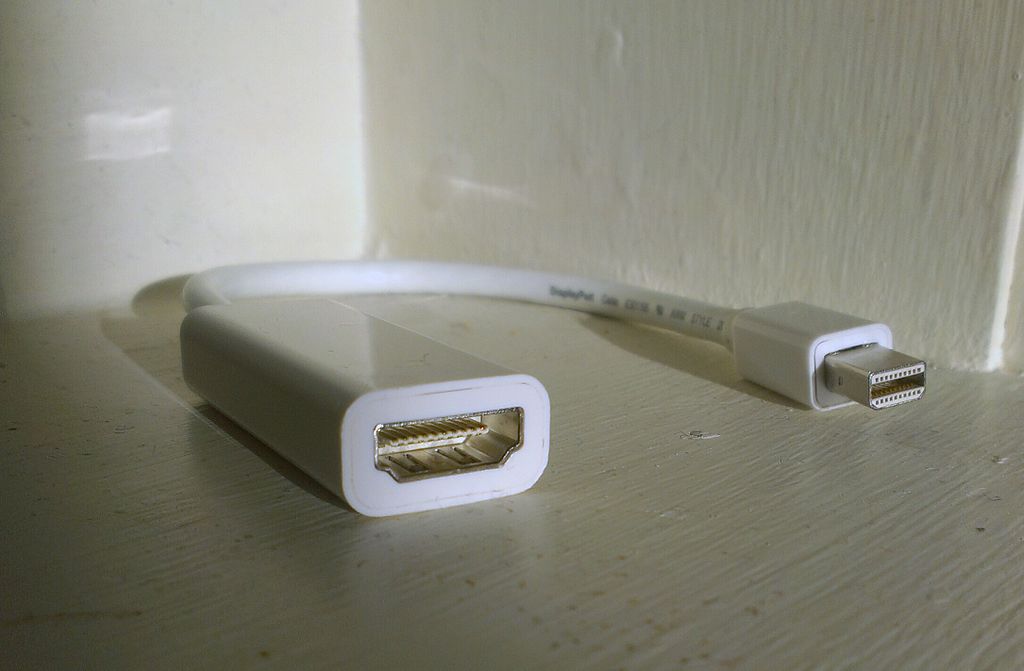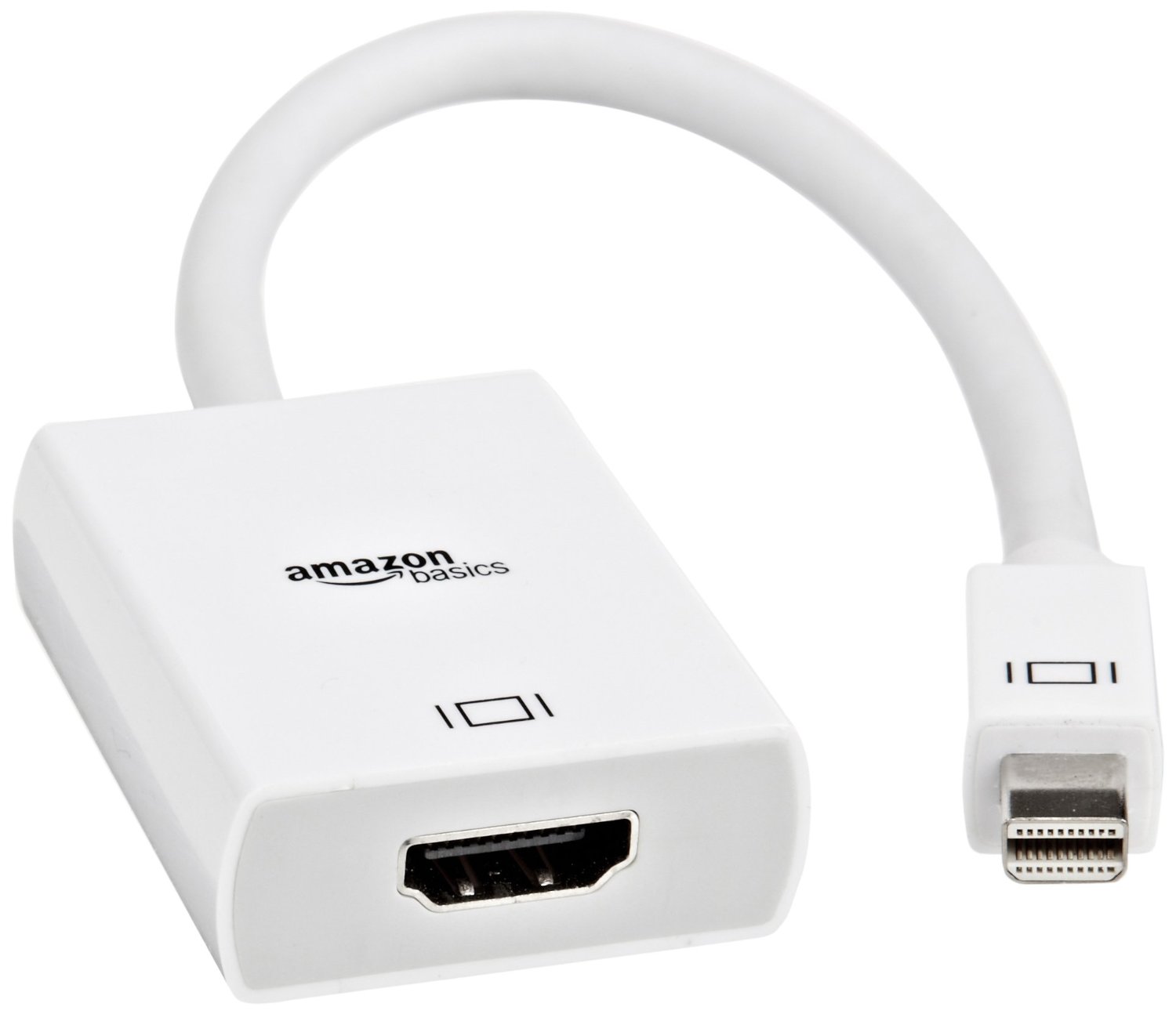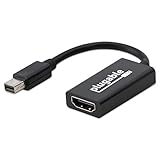DisplayPort to HDMI: 3 Best Adapters Available In The Market

Image from Wikimedia Commons
Depending on your setup, you might not have access to an HDMI output. Certain laptops still utilize DisplayPort cables, making them incompatible with many modern monitors and TV’s. Thankfully, it’s pretty easy to find an adapter that will make up for the lack of a correct connection in your computer.
There are many cables out there for converting DisplayPort to HDMI, but you’ll want the best of its kind. Don’t settle for a shoddy cable that doesn’t have the correct material and shorts out after only a few uses.
Comparison Table

AmazonBasics Mini DisplayPort to HDMI Cable – 3 Feet
| Preview | Product | |
|---|---|---|

|
Cable Matters Mini DisplayPort to HDMI Adapter (Mini DP to HDMI) in... | Check Price |

|
Plugable Active Mini DisplayPort (Thunderbolt 2) to HDMI 2.0 Adapter... | Check Price |
Why Do You Need a DisplayPort to HDMI Cable?

Image from Wikimedia Commons
The short answer to this question is that DisplayPort is no longer a viable option. There was a time when it seemed DisplayPort could be a viable option for transmitting an HD signal from a computer to a monitor. While it’s still included, it’s much easier to simply use an HDMI connection, especially when hooking up to a larger TV or monitor.
During the initial launch of Thunderbolt, it helped kickstart the use of the DisplayPort connection. There was a time when it wasn’t seen as a tiny niche for video connection, and DisplayPort looked like it could be the next big thing in HD connections. With Thunderbolt, you get all the luxuries of DisplayPort, PCI Express, and DC Power shoved into one single outlet.
Of course, technology grows with the passage of time. Every device now moves faster, sounds clearer, and looks sharper than anything we had less than 10 years ago. You’ll quickly find other cables you once utilized collecting dust in the corner thanks to outdated connections.
For about 8 years, Apple went with DisplayPort as its proprietary video out for most Mac devices. Back in 2010, Toshiba, Dell, and other PC manufacturers used the format to sell people on HD hookups for their new computers. Mini DisplayPort was everywhere, and you could easily feel left in the dust if you didn’t have it as a main input for your computer’s A/V setup.
Today, however, DisplayPort is a thing of the past. Once HDMI took over as the standard for sending high-definition audio and video through one cable, it was clear that DisplayPort’s days were numbered. If you’re still using a computer that sends audio and video out through a DisplayPort cable, you’ll need a great adapter that does the job.
What Screen Resolutions Work with DisplayPort to HDMI Adapters?
One of the things you’ll need to check before picking up an adapter is the resolution you’ll be using with your computer monitor(s). If you go with one that only reaches a 1080p signal, you’ll max out the possible picture quality with your adapter.The same thing goes for your refresh rate, as you’ll need an adapter that can handle a higher number of frames if you’re working with a capable monitor.Simply put: a 4K signal won’t go through a cable designed to hold a 1080p picture, and if you have a refresh rate of something like 120Hz, HDMI 2.0 isn’t going to cut it.If you aren’t a serious gamer or animator, you probably won’t have to worry so much about these extra resolutions and frame rates. Of course, you might be thinking about the future and the kinds of resolutions that might become standard down the road.If this is the case, you need an adapter that’s future-proof. Look into a cable that can support resolutions that go above “normal” HD signals if you want to stay relevant over the next decade.
Should You Get a Passive or Active DisplayPort to HDMI Adapter?
Deciding between active or passive adapters can make a difference in the performance of your picture quality. With active adapters, you’ll find a chip inside the adapter box that helps the signal conversion. The active aspect of the adapter works more dynamically than one that passively converts the signal.Your need for an active vs. passive adapter is going to depend on how you are connected to each monitor. If your device uses DP++, it can convert all of the necessary data without any help from an adapter. Without a dual-port mode, you’re going to need one of the active kinds of adapters. Thankfully, Thunderbolt supports DP++ natively.If you’re stuck with a Mini DisplayPort device that doesn’t use Thunderbolt, you’ll need to find an active DisplayPort to HDMI adapter that takes care of the extra work. All you need to do is check if the Mini DisplayPort on your device has a DP++ symbol. If you see it, you don’t need to worry, and you’ll be fine with a passive adapter.One more reason to get yourself an active adapter is to run multiple displays from one device. Many people now use at least two monitors at the office. You’ll need to consider this for home if you’re planning on using a few displays at the same time. There are also video cards out there that won’t let you use multiple monitors while utilizing DP++.The best thing to do is check your GPU’s manufacturer or manual if you need to confirm. Finding out the DP++ compatibility of your graphics card will tell you whether or not you have to look for an active adapter.
Why Does a DisplayPort to HDMI Adapter Fail?
Have you ever purchased a cheap cable in the past, only to see it stop working within a few short months? This goes back to faulty design, and it’s something you can avoid by looking for the best DisplayPort to HDMI adapter before you buy.Avoid any adapters with a giant connection head. Not only is this a bad design choice and makes the cable prone to failure, but it makes other devices difficult to plug in to other open HDMI slots.Adapters can break when their ends are bent while still hooked up to a device. This is more common than you might think and can happen without warning. A simple readjustment of a gaming console or TV for dusting and cleaning can ruin the connection if your devices are still plugged in. Even without this kind of jostling, you may still find cables that fail to do regular usage.Most of the time, adapters that die from wear and tear stem from constant bending or pulling. You’ll notice this especially with headphones, since each side of the listener’s end is wired separately. When the strain of one wire is too much, it will cause the failure of one side, and you’re stuck listening to songs and podcasts through one ear. This same issue can happen in an adapter.
Deciding on the Correct DisplayPort to HDMI Adapter
Where do you plan on using your adapter? This is something you should ask, as there are different kinds of solutions. Some are built for desk use, and others are designed to be taken wherever you go.You won’t have to worry about weight too much, since most of these adapters only weigh a couple ounces. This makes shipping cost minimal as well. You will want to check the length of the cable, as this could be a huge factor in hooking up a laptop vs. a desktop to a bigger TV or monitor.
How We Chose Our Ratings
The final ratings for each converter were based on simple factors. Availability and price were at the top of the priorities for each adapter, as they are the biggest factor when taking convenience into consideration.Compatibility across all connections was another huge influence on the final scores. The materials that make the cable slightly influenced decision-making. Finally, name brand was considered when issuing a final review.
The Top 3 Best DisplayPort to HDMI Adapters
AmazonBasics
AmazonBasics Mini DisplayPort to HDMI Cable – 3 Feet
4.5 out of 5 stars
The AmazonBasics adapter is designed to provide everything you need in a cheap and easy-to-plug cable. This cable can hold signals up to 1080p, which is still the most common HD resolution on the market.
A plastic sheath guards the cord, extending by 9 inches to give you the protection you need against dust and dirt. Thanks to this extension, you have a bit more breathing room between your computer and other devices when using an HDMI cable.
It’s obvious that this adapter was designed for Mac devices. Just looking at the color tells you about the intent for parity with other electronics in the iOS family. Although there aren’t too many reported issues of compatibility with plugging a Windows device into one of these adapters, it’s not impossible. Keep this in mind if you’re looking for an adapter for a computer running anything by Microsoft.
This AmazonBasics adapter isn’t going to do anything fancy, but the brand name never makes any promises. If you need something that plugs in and functions, the AmazonBasics cable is the choice for you. As noted above, this is not the kind of adapter you’ll want if you’re working with multiple monitors.
Even though this is a very affordable adapter, you don’t want to buy something unprotected. AmazonBasics covers their adapters for a year, so any defects will be covered.
Cable Matters
- Lightweight and portable adapter for connecting a Mini DisplayPort (Mini DP or mDP)/Thunderbolt 2 port compatible...
- Transmits both audio and video from computer or tablet to HDTV display; Supports video resolutions up to 1920 x 1200 and...
- Low-profile connector does not block adjacent ports on your computer, has molded strain-relief for long life, and has...
4.5 out of 5 stars
Of the adapters tested for this list, the model by Cable Matters definitely has the lowest profile. You won’t have any problems with multiple devices or blockages with the other cables, but if space is your biggest concern, the Cable Matters adapter should be your first choice. Resolutions of up to 1080p are supported, along with uncompressed 5.1 and 7.1 digital audio.
In a nice touch, Cable Matters includes some very small nubs to ease with inserting and removing the wire. The wire has some girth to it, giving it a feeling of quality build that you won’t often find with cheap products. The shorter 4-inch adapter cable loses some points for practicality, but it also means you can pack it up easily.
As you’ll typically see on packaging, Cable Matters likes to brag about the gold plating on the cable head. The truth is that this doesn’t make much of a difference for connections between devices. Eventually, anything with copper is going to oxidize, turning very unsightly and dropping performance over time. Gold gives you a slight advantage in this area, but not enough to justify a huge difference in spending.
Although Cable Matters has a ridiculous number of products they support, all of them have a Mini DisplayPort attached to them. As long as you purchase one with the correct end on the cable, you’ll be set.
Plugable
- Active adapter enables you to connect a Mini DisplayPort video output from your laptop, tablet, or desktop PC to...
- Supports resolutions up to 3840x2160 (4K) Ultra-HD @ 60Hz, 1080P@120Hz. Does not support HDR displays. Supports...
- AMD Eyefinity compatible. VESA (DisplayPort) certified. Compliant with VESA Dual-Mode DisplayPort 1.2, High Bit Rate 2...
5 out of 5 stars
For those of you who wield more than two devices, you need an adapter that will keep up with your pace. Furthermore, the other two adapters on this list cannot handle ultra-high-end picture and audio. This is where Plugable enters the arena and easily wins in sheer strength.
The DisplayPort to HDMI adapter from Plugable can handle resolutions all the way up to 3840X2160. You’ve probably heard this referred to as 4K, or Ultra HD. If you’re running a 1080p signal, the refresh rate can be set up to 120 Hz. Anything on Ultra HD settings is going to be locked at 60 Hz if you’re using this adapter.
Along with superior video, this adapter can handle 32 channels of audio, unlike the 8 you would get with a typical HDMI setup. Just be sure that all of your devices are compatible with at least HDMI 2.0, which you can tell by their respective HDMI symbol on each input.
Buyer’s Guide
Choosing the proper DisplayPort to HDMI adapter mostly comes down to the equipment you are working with. If you’re someone who simply needs to convert the signal and doesn’t care about performance, the only thing you need to look at is your device. If you’re an Apple user, the safe choice is to use AmazonBasics. Those with anything from the Windows family should stick to Cable Matters.
For someone who has a monitor or tower on the higher end and needs maximum power from video and audio, Plugable has you covered. Neither of the other two cables are capable of dealing with multiple connections, and serious gamers should go with the brand that can handle their rigs.
Above all, the most important thing to do is check your computers first to see what is needed. It’s easy to make a mistake and find out you actually need a DVI-to-DisplayPort, HDMI-to-DVI, or some other combination of PC connections. Once you figure out what’s going in and out, determine your OS, find out how many connections you have, and buy your adapter.
Keywords: Displayport to HDMI









